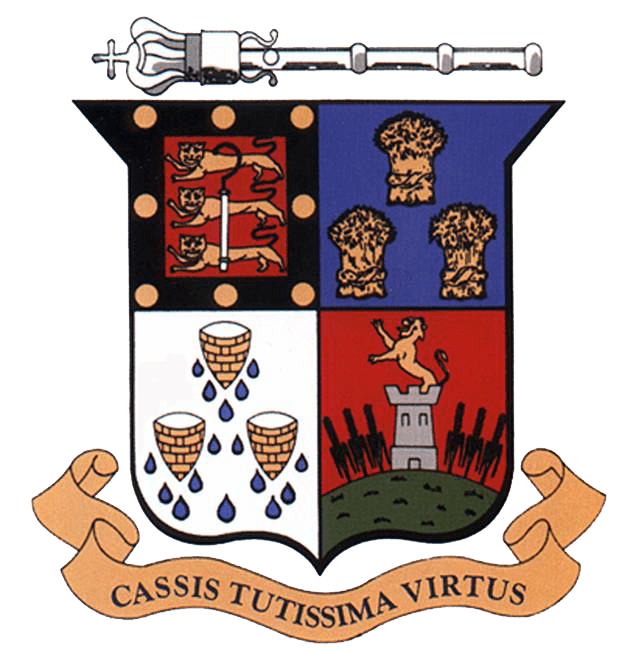Before Town Park: 145 years of Winsford gas works
Long before Winsford Town Park was created, Dene Clough was better known as the home of Winsford gas works, an enterprise which occupied the lower end of the clough for 145 years.
Let there be light
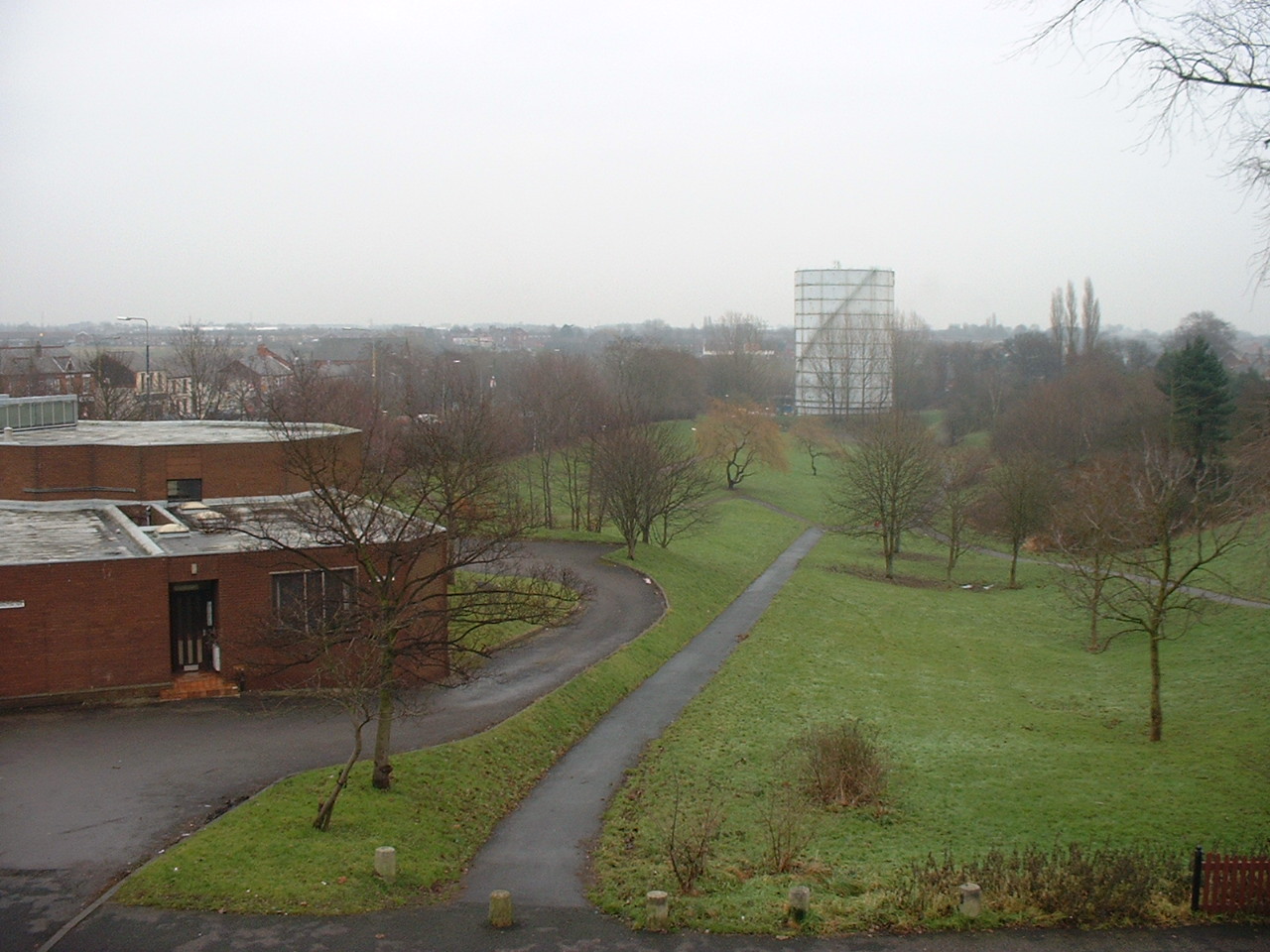
A 1950s gas holder marks the location of Winsford gas works at the lower end of Dene Clough.
Photograph c.2000, before the clough was transformed to become Winsford Town Park.
St Andrew's Church to the left.
(Image © Keith Andrew, used with permission.)
Winsford's gas story begins in early 1857, when the Over and Wharton Gas Company was formed by local tradespeople, with the sole purpose of bringing gas lighting to the streets. Their motivation was founded on a business need: how to extend trading hours beyond the hours of daylight. It also meant the company had a commercial product to sell, as coal gas could be sold to the Local Board (forerunner of the town council) to light the streets, to householders, and to places of work.
A Rochdale gas engineer was contracted to build the company's gas works, and a site was chosen at the lower end of High Street, in the small valley or clough through which the Dene Brook flowed. By late 1857, the works were completed with iron mains laid to take coal gas to shops and to some private homes. It had taken just 14 weeks to construct the works and lay the pipes – all three miles of them. The cost was £2,000.
Winsford's gas supply began flowing on Boxing Day, 26th December 1857, a Saturday, when coal gas from the Over and Wharton Gas Company burned brightly from Winsford’s first gas street lights.
A few days later, on Wednesday, 6th January 1858, a celebration dinner was held at the Wheatsheaf Inn, Delamere Street, Over, followed by public illuminations throughout the townships of Over and Wharton, all lit by gas.
A large star and garter with the initials of the Over and Wharton Gas Company was set up opposite the Wheatsheaf Inn; a Brunswick star (an eight-pointed star) was opposite Over post office; a star set between the initials of Victoria Regina could be seen on High Street; and a Brunswick star shone opposite the Red Lion Inn, near Town Bridge, set with the initials SD, for Stephen Duncan, the landlord.
At the annual shareholders' meeting, the company directors announced the year's dividend and the price of gas for the year ahead, together with the profits made from the sale of by-products from the manufacture of coal gas (mainly coke and coal tar – the company had a tar pit at its works).
But, there were times when matters beyond the control of the company plunged Over and Wharton back into darkness. This is what happened in November 1893, when a nationwide miners’ strike forced the company to write to its customers, saying the supply of gas was to be discontinued, due to a scarcity of coal. The lights were out for a few days, until the company was able to secure several truck-loads of coal.
Changes of ownership
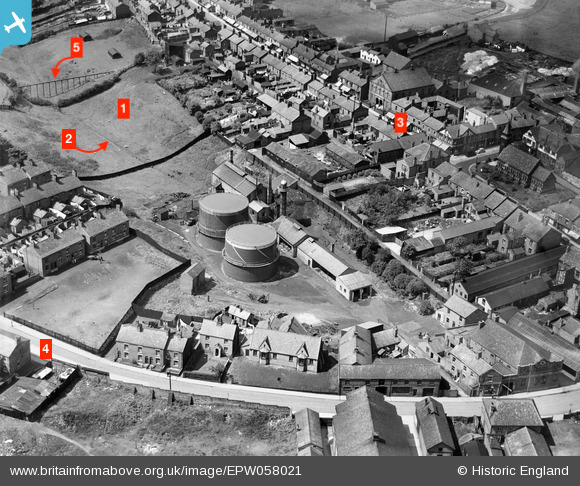
Aerial photograph of Winsford gas works, 1938.
Key: (1) Dene Clough (2) Dene Brook
(3) High Street
(4) Weaver Street (5) Raised sewage pipe taking sewage and rainwater from High Street
and Clough Row to filter beds at Bottom Flash. Click image to enlarge.
(Image © Historic England Britain From Above.)
As the twentieth century dawned, privately-owned gas works were subject to takeover by local authorities, for which Acts of Parliament were required. In 1901, the Winsford Urban District (Gas Transfer) Act saw the business of the Over and Wharton Gas Company transferred into public ownership ("Municipalising a Cheshire Gas Company" was the headline in the Manchester Evening News). The cost to Winsford Urban District Council (WUDC) was £15,862, financed by a 30-year loan.
For 35 years, WUDC managed the gas works and the mains which piped "town gas" (as it was known) around Winsford.
The 1930s saw the coalescence of gas companies into larger organisations, and in 1936 WUDC sold its gas works to the privately-owned Severn Valley Gas Corporation Ltd for £32,000, giving Winsford's ratepayers a profit of £20,000.
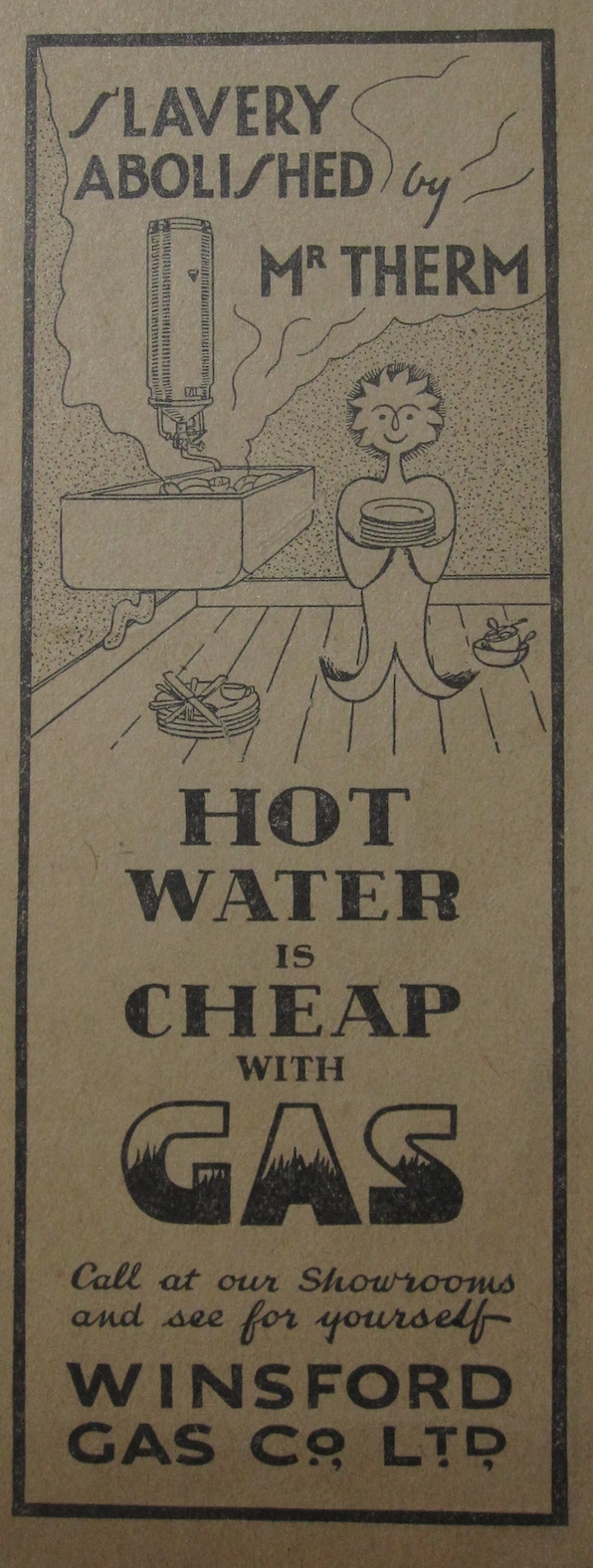
Winsford Gas Company advert on a Winsford library bookmark, 1938.
The 1946 and 1949 floods
Winsford was severely affected by major flooding in February 1946, when the River Weaver burst its banks. "Fish Float Through Front Doors" was the headline in the Winsford Chronicle of 16th February.
Properties in Market Place, at the lower end of High Street, were under four-feet of floodwater, and the post office, built on the site of the former Bridge Salt Works, near Town Bridge, subsided and was rendered unusable for many years after. The gas mains flooded, and for a few hours Winsford was without gas.
Three years later, in November 1949, following heavy rain, the gas works were affected by flooding – but not from the River Weaver.
"Water raced down the valley behind the town's main streets and flooded cellars in the gas works", reported the Winsford Chronicle of 12th November, adding that it "swirled into the gas works instead of passing below ground to the river."
The culprit was a blocked culvert through which the Dene Brook flowed under the gas works and into the Weaver. Until the culvert could be unblocked, council workmen built a temporary dam across the valley, holding the Dene Brook and its floodwater back, creating a small lake in what is today Winsford Town Park.
Nationalisation
In 1948, the gas industry was nationalised. The Gas Act 1948 brought more than 600 private gas companies into public ownership: number 610 on the list was the Winsford Gas Company Ltd. Gas made in Winsford was then supplied to the new National Grid and, in turn, Winsford took its gas from the Grid, much of it coming from a huge new gas works at Partington, near Manchester.
With the rise of large, regional suppliers, the days of provincial gas works were numbered, and on Tuesday, 31st March 1953, the furnaces at the Winsford gas works were put out, and gas production ceased after almost 100 years.
Electrification
Winsford's streets were lit by gas until the 1950s. In November 1952, WUDC agreed to replace gas lights with electric lights (sodium lights), financed by the proceeds of the sale of the gas works in 1936. The £20,000 profit from the sale had been invested by the council, and £13,700 was released to provide Winsford's first electric street lights, with work to light the mile-long High Street from Over Square to Town Bridge commencing in October 1953.
A "monstrous eyesore"
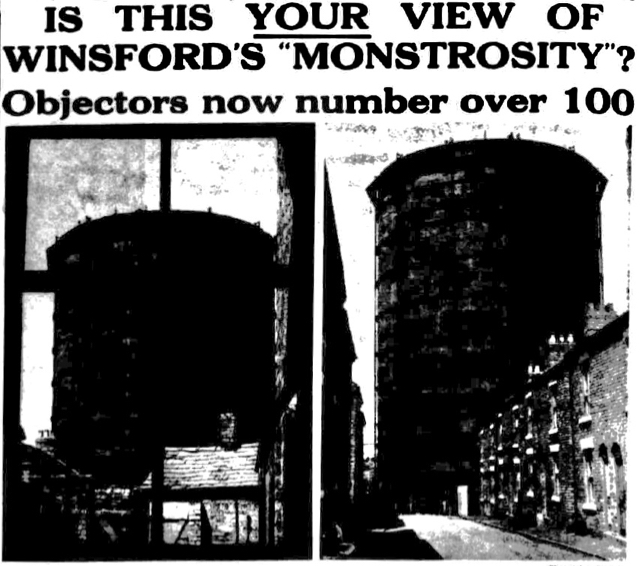
Winsford Chronicle headline, 12th May, 1956. The photographs show the gas holder from a resident's living room,
76 Weaver Street (left); and as it appeared at the end of Winnington Street (right).
(Image © Reach PLC. Image created courtesy of The British Library Board /
British Newspaper Archive.)
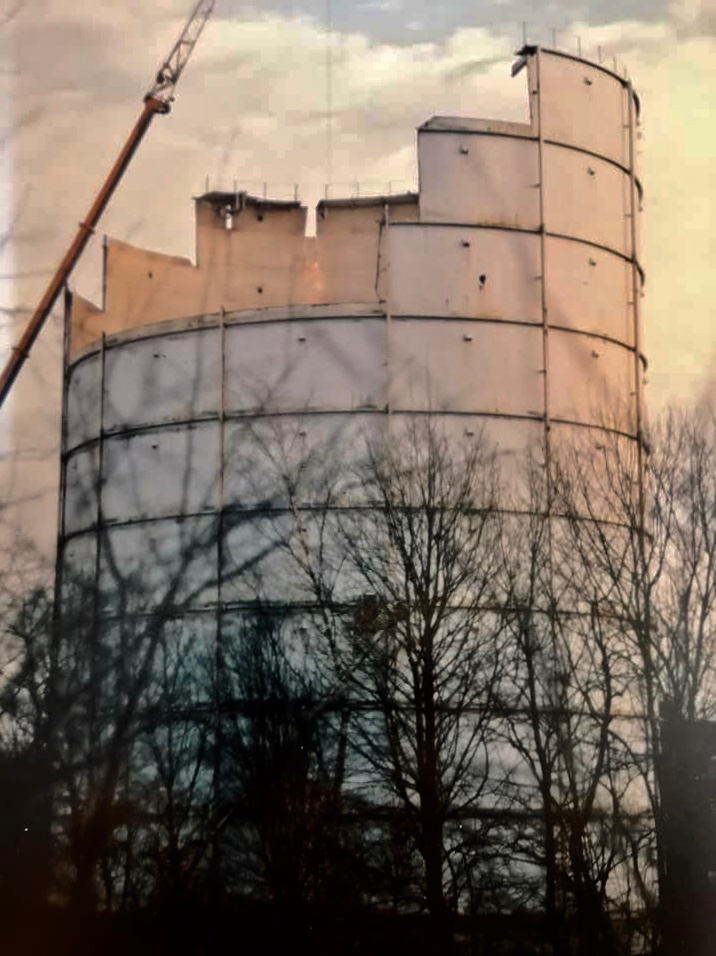
Demolition of the Winsford gas holder in 2002, described as both a "landmark" and an "eyesore".
(Image © Tina Icely, used with permission.)
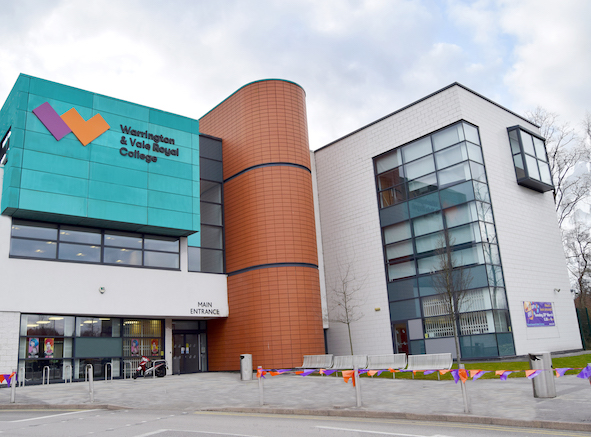
Winsford Campus of Warrington & Vale Royal College, built on the site of the Winsford gas works,
its prominent rounded lift shaft perhaps a memory of the gas holder it replaced.
Winsford’s connection with the gas industry didn’t end with the extinguishing of the furnaces or the coming of electric street lights.
In 1956, the North West Gas Board, who owned the site of the former Winsford gas works, built a 128-foot tall gas holder (or gasometer) there at a cost of £73,000 – without consulting residents or WUDC.
The council was "angry" and residents were "bitter", which is how the local press described the giant metal tank which blotted out daylight to residents in Weaver Street and Winnington Street, who called it an "ugly monster", a "rusty object", and a "monstrous eyesore".
Residents living across the River Weaver in Hill Street, Wharton, complained of double images on their TV sets, and blamed the gas holder for interfering with the signal.
A petition was organised calling on the town council to take all possible steps to have the tank removed. It was signed by more than 100 residents.
WUDC sought legal opinion, and were advised by counsel that it would be a "waste of money to attempt to challenge the Gas Board's action": the Gas Board was not required to consult WUDC (the Board had, in fact, built the gas holder with the consent of Cheshire County Council).
However, the Gas Board was willing to make one concession to WUDC: the council could choose what colour the tank was to be painted. A councillor asked if "invisible paint" could be used: the council proposed light grey, which the Gas Board agreed to.
A local landmark
As the years passed, the 1950's gas holder became a well-known Winsford landmark, surviving the reshaping of the town in the 1960s and '70s. Its grey steelwork was periodically repainted, and its final colour was a light blue.
Eventually, though, like gas holders across the country, it was decommissioned by the National Grid, and plans were made to demolish it.
A report in the Winsford Guardian, 17 April 2002, stated that "Winsford's skyline will be free of the town's eyesore gas holder by the end of the year". Not everyone was glad to see the tower come down: a local historian described it as a "reassuring landmark and part of Winsford's heritage".
By the end of 2002, Winsford's gas holder had been demolished, ending a 145-year connection with gas which had begun on Boxing Day, 1857.
Article researched and written by John Malam, 2021.

 Menu
Menu

